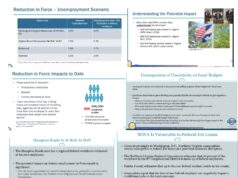I saw this article earlier today, about how “For the first time, Montgomery [County, Maryland]’s elected school board is composed of a majority of people of color.” The article further notes that, “Across the country, 78 percent of board members are white, while 10 percent are black and 3 percent are Hispanic.” That made me curious to see how diverse major Virginia counties and cities are when it comes to their County Boards and School Boards. We’ll start with the largest Virginia county, the one that’s sometimes compared to Montgomery County, Maryland…
Fairfax County: According to this 2018 report, Fairfax County’s population is now 61.1% white, 19.5% Asian/Pacific Islander, 16.2% Hispanic, 9.7% black and 9.4% “other.” [Note: In these statistics, Hispanic persons may be of any race, so the percentages add to more than 100%] The Fairfax County public school student population, according to this source, is 38.5% white, 25.9% Hispanic, 19.6% Asian, 10% black and 5.5% of “two or more races.” In contrast, the School Board (12 members total) currently is comprised of nine white members (75% of the Board), one African American (Karen Keys-Gamarra), one Asian American (Ilryong Moon) and one Hispanic (Dalia Palchik, who is leaving to run for County Board). The County Board (9 members plus the chair) is all white, other than Catherine Hudgins, who is African American (and rumored to be retiring). So…yeah, the County Board is definitely not reflective demographically of this highly diverse county, nor is the School Board.
Arlington County: According to this, Arlington County’s population is now 64.0% white, 15.1% Hispanic/Latino, 9.6% Asian/Hawaiian/Pacific Islanders, 3.0% “Other and Multi-Racial.” Arlington’s public schools as of 10/31/17 were 46.4% white, 28.2% Hispanic, 9.7% Black/African American, 9.1% Asian and 6.2% “Multiple.” For its part, the School Board (5 members total) is comprised of three whites (60%), one Latina (20%) and one African American (20%), while the County Board (5 members total) is comprised of…also four whites (80%) and one African American (20%). So, Arlington’s County Board is not particularly reflective demographically of the demographics of Arlington as a whole, starting with the fact that it has zero Hispanics and zero Asian-Americans. The School Board is roughly reflective…
Loudoun County: According to the U.S. Census Bureau, as of July 1, 2018, Loudoun County’s population was 56.1% non-Hispanic white, 19.4% Asian American, 13.9% Hispanic/Latino, 7.9% African American, and 3.8% “Two or More Races.” The Loudoun County public schools are comprised of 48% white students, 22% Asian Americans, 18% Hispanics, 7% African Americans and 6% MultiRacial. In contrast, the Loudoun County Board (9 members total) is comprised of 7 whites (78%) and 2 African Americans (22%), while the School Board (9 members total) is 100% white. So…yeah, not even close to reflecting this highly diverse county, including the fact that there are ZERO Hispanics/Latinos or Asian Americans on either Board, despite those two groups combined making up around one third of the county’s population.
Prince William County: According to the U.S. Census Bureau, as of July 1, 2018, Prince William County’s overall population was 42.8% non-Hispanic white, 23.6% Hispanic/Latino, 22.1% African American and 9.1% Asian American. The public schools as of 2017 were 33.9% Hispanic/Latino students, 30.7% white students, 20.4% African-American students, 8.6% Asian-American students and 5.9% “Two or More Races.” The Prince William County Board of Supervisors, in stark contrast, was 100% white, with neo-Confederate/white nationalist Corey Stewart as Chair. So…no, this isn’t even CLOSE to being reflective of Prince William County’s demographics. It’s also not even CLOSE to being reflective of the partisan makeup of the county, only two Democrats out of eight members, despite an increasingly “blue” county for president, governor, Congress, the General Assembly, etc. The School Board is more reflective of Prince William County’s demographics, but still not there yet – especially when you look at the County Board. In 2019, it’s time for some serious change in Prince William County government!
Henrico County: According to the U.S. Census Bureau, as of July 1, 2018, Henrico County’s overall population was 53.2% non-Hispanic white, 30.6% African American, 8.8% Asian American, 5.6% Hispanic/Latino, 2.4% “Two or More Races.” The Henrico County Public Schools in 2017-2018 were 39% white, 36% African American, 11% Asian American and 10% Hispanic (of any race). The Board of Supervisors (5 members total) had three whites (60%) and two African Americans (40%) and the School Board (5 members total) had four whites (80%) and one African American (20%).
Virginia Beach: According to the U.S. Census Bureau, as of July 1, 2018, Virginia Beach’s population was 61.7% non-Hispanic white, 20.2% African American, 8.2% Hispanic/Latino, 7.2% Asian American and 4.2% “Two or More Races.” According to this, Virginia Beach public schools are around 63% white students, 19% African Americans, 7% Hispanics and 6.5% Asian Americans. The Virginia Beach City Council (11 members total) has 10 whites (91%) and 1 African American (9%), while the School Board (5 members total) has four whites (80%) and one African American (20%). Not particularly reflective of the city’s demographics…
Norfolk: According to the U.S. Census Bureau, as of July 1, 2018, Norfolk was 43.6% non-Hispanic white, 42.5% African American, 8.0% Hispanic/Latino, 3.8% Asian American and 3.7% “Two or More Races.” Norfolk public schools in 2011 were 63% African-American students, 23% whites, 6% Hispanics (of any race), 6% of two or more races and 2% Asian Americans. The Norfolk City Council is comprised of four whites and four African Americans (including the mayor), and the School Board is three white, three African American and one Asian American. Overall, highly diverse representation for a highly diverse city.
Richmond City: According to the U.S. Census Bureau, as of July 1, 2018, Richmond City’s population was 48.8% African American, 41.0% non-Hispanic white, 6.7% Hispanic/Latino, 2.3% Asian American and 2.2% “Two or More Races.” Richmond City public schools are around 75% African American, 13% Hispanic, 9% white and 1% Asian American. The Richmond City Council is comprised of six white members and three African Americans, while the School Board is 50/50 African American and white. So…pretty diverse representation, although no Hispanics and more whites than the demographics would suggest.
Alexandria: According to the U.S. Census Bureau, as of July 1, 2018, Alexandria’s population was 51.6% non-Hispanic white, 23.4% African American, 16.6% Hispanic/Latino, 6.7% Asian American and 3.1% “Two or More Races.” The Alexandria City public schools are 36% Hispanic, 28% white, 27% African American, 5% Asian American and 3% Multi-racial. The Alexandria City Council will be changing shortly, but right now it’s four whites, two African Americans and one multi-racial member. The Alexandria School Board also will be changing shortly, but right now is comprised of seven whites and two African Americans. So…clearly, the demographics of the School Board have not been closely reflective of the public school student demographics.
Chesterfield County: According to the U.S. Census Bureau, as of July 1, 2018, Chesterfield County’s population was 60.7% non-Hispanic white, 18.1% Hispanic/Latino, 13.4% African American, 5.8% Asian American and 2.7% “Two or More Races.” The Chesterfield County Board (five total members) is 80% white and 20% African American, while the School Board is 80% white and 20% Asian American. Not particularly diverse, particularly when it comes to Hispanics/Latinos.
Stafford County: According to the U.S. Census Bureau, as of July 1, 2018, Stafford County’s population was 61.8% non-Hispanic white, 19.0% African American, 12.8% Hispanic/Latino, 3.6% Asian American and 4.2% “Two or More Races.” The Stafford County Public Schools are around 65% white, 17% African American, 10% Hispanic 4% “Mixed” and 3% Asian American. In contrast, the Stafford County Board of Supervisors (seven members) is 100% white, while the School Board (nine members) is 89% white (one African-American member). So…no, the demographics of Stafford County government do NOT reflect the demographics of the county.
Spotsylvania County: According to the U.S. Census Bureau, as of July 1, 2018, Spotsylvania County’s population was 68.3% non-Hispanic white, 16.7% African American, 9.8% Hispanic/Latino, 2.9% Asian American and 3.4% “Two or More Races.” The Spotsylvania County Board (seven members), in contrast, is 100% white, and the School Board (seven members) is 86% white. So…not particularly reflective of the county’s demographics.
Albemarle County: According to the U.S. Census Bureau, as of July 1, 2018, Albemarle County’s population was 76.7% non-Hispanic white, 9.8% African American, 5.8% Hispanic/Latino, 5.4% Asian American and 2.6% “Two or More Races.” The Albemarle County Board of Supervisors (six members) is 100% white, while the School Board has one African-American member. So…not a particularly diverse county government for a fairly diverse county.
Roanoke City: According to the U.S. Census Bureau, as of July 1, 2018, Roanoke City’s population was 60.7% non-Hispanic white, 18.1% Hispanic/Latino, 13.4% African American, 5.8% Asian American and 2.7% “Two or More Races.” The Roanoke City public schools in 2014-2015 were around 45% African American, 39% white, 10% Hispanic, 3% Asian American and 3% MultiRacial. The Roanoke City Council (seven members) has five whites and two African Americans, while the School Board (seven members) is also comprised of five whites and two African Americans. Neither is particularly reflective of the city’s overall demographics, let alone school demographics…
Charlottesville: According to the U.S. Census Bureau, as of July 1, 2018, Charlottesville’s population was 65.7% non-Hispanic white, 18.9% African American, 7.2% Asian American, 5.2% Hispanic/Latino and 3.1% “Two or More Races.” The Charlottesville City public schools are 41% white, 33% African American, 12% Hispanic/Latino, 8% Asian American and 7% “other.” The Charlottesville City Council (five members) is comprised of three whites and two African Americans, while the School Board (seven members) has four white members and three African Americans. Actually, pretty reflective of the city’s demographics, other than no Latino or Asian-American representation.



 Sign up for the Blue Virginia weekly newsletter
Sign up for the Blue Virginia weekly newsletter








